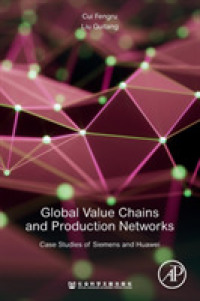- ホーム
- > 洋書
- > 英文書
- > Science / Mathematics
Full Description
The Welding Engineer's Guide to Fracture and Fatigue provides an essential introduction to fracture and fatigue and the assessment of these failure modes, through to the level of knowledge that would be expected of a qualified welding engineer. Part one covers the basic principles of weld fracture and fatigue. It begins with a review of the design of engineered structures, provides descriptions of typical welding defects and how these defects behave in structures undergoing static and cyclical loading, and explains the range of failure modes. Part two then explains how to detect and assess defects using fitness for service assessment procedures. Throughout, the book assumes no prior knowledge and explains concepts from first principles.
Contents
Dedication
Woodhead Publishing Series in Welding and Other Joining Technologies
Preface
Part One: Principles of weld fracture and fatigue
1: Designing engineered structures
1.1 Introduction
1.2 The first engineered structures
1.3 Successful structures
1.4 Materials and fabrication methods
1.5 Industrialisation: benefits and consequences
1.6 Conclusions
2: Structures under load
2.1 Introduction
2.2 Sources of loading
2.3 Types of loading
2.4 Loads experienced during construction
2.5 Design approach
2.6 Axial and bending stresses
2.7 Conclusions
3: Welding problems and defects
3.1 Introduction
3.2 'Workmanship' defects
3.3 Weldability
3.4 Fabrication cracking in welds
3.5 Other types of weld defect
3.6 Welding residual stresses
3.7 Distortion
3.8 Conclusions
4: Design for static loading
4.1 Introduction
4.2 Load-extension curves
4.3 Stress-strain curves
4.4 Static limit state design
4.5 Conclusions
5: Brittle fracture and the behaviour of cracks in structures
5.1 Introduction
5.2 Nature of brittle fracture
5.3 The three factors for brittle fracture
5.4 Ductile-to-brittle transition
5.5 Welding and fabrication codes
5.6 Principles of fracture mechanics
5.7 Fracture toughness parameters
5.8 Conclusions
6: Structures under cyclic load
6.1 Introduction
6.2 Engineering perspective of fatigue
6.3 Metallurgical perspective of fatigue
6.4 Practical implications for a growing fatigue crack
6.5 Conclusions
7: Fatigue of welded joints
7.1 Introduction
7.2 Fatigue performance of welded joints
7.3 Special features of welded joints
7.4 Fatigue design of welded joints
7.5 Stress histories of real structures: variable amplitude loading
7.6 Fatigue of welded aluminium
7.7 Conclusions
8: Failure modes and analysis in metals
8.1 Introduction
8.2 Ductile failure
8.3 Brittle fracture
8.4 Fatigue failure
8.5 Scanning electron microscopy (SEM) of fracture surfaces
8.6 Interpreting fracture faces
8.7 Corrosion
8.8 Engineering failure investigations
8.9 Conclusions
Part Two: Testing, analysis and assessment of weld fracture and fatigue
9: Mechanical testing of welds
9.1 Introduction
9.2 Weld procedure qualification
9.3 Bend testing
9.4 Tensile testing
9.5 Charpy testing
9.6 Fracture toughness testing
9.7 Fatigue testing
9.8 Creep testing
9.9 Corrosion testing
9.10 Macrographic sections
9.11 Hardness testing
9.12 Conclusions
10: Detecting weld defects
10.1 Introduction
10.2 'Perfect' welds and detection of weld defects
10.3 Visual inspection
10.4 Dye penetrant inspection
10.5 Magnetic particle inspection (MPI)
10.6 Eddy-current testing
10.7 Radiography
10.8 Ultrasonic testing (UT)
10.9 Probability of detection
10.10 Flaw-sizing error
10.11 Choosing suitable non-destructive testing (NDT) methods
10.12 Conclusions
11: Weld defect assessment
11.1 Introduction
11.2 Fitness-for-service assessment
11.3 When to carry out an engineering critical assessment (ECA)
11.4 Standards for assessment methods
11.5 Input data for ECA
11.6 Failure assessment diagrams (FAD)
11.7 Proximity to failure and safety factors
11.8 Refining the assessment
11.9 Conclusions
12: Weld fatigue assessment
12.1 Introduction
12.2 Using fracture mechanics to describe fatigue crack growth
12.3 The power law (Paris equation)
12.4 Assessing weld flaws under fatigue loading
12.5 Advanced fatigue crack growth assessment
12.6 Conclusions
13: Improving the fracture performance and fatigue life of welded joints
13.1 Introduction
13.2 Fatigue improvement measures to be taken before welding
13.3 Fatigue improvement techniques for welds
13.4 Other fatigue considerations
13.5 Improving fracture performance
13.6 Using this book: repair of fatigue cracks
13.7 Conclusions
Index








